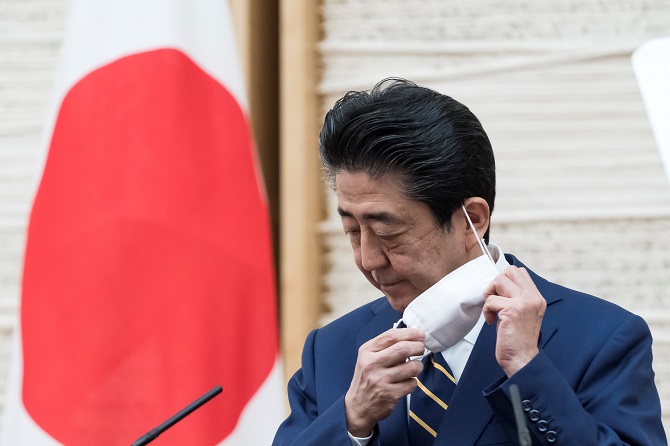‘Both India and Japan can find themselves in a win-win situation if they draw some lessons from each other’s strengths,’ says Dr Rajaram Panda.
IMAGE: Japan’s Prime Minister Abe Shinzo removes his face mask at a press conference in Tokyo, April 7, 2020, where he announced a state of emergency. Photograph: Tomohiro Ohsumi/Pool via Reuters
At the time of writing this column, more than 3,906 people have tested positive for the coronavirus in Japan with 91 deaths.
Though this number might not look alarming compared to hot spots elsewhere, the spike in the numbers in Tokyo with 1,116 confirmed cases so far and surging by over 100 every day in Tokyo is a matter of worry for the government.
Prime Minister Abe Shinzo was left with no option but to make the announcement on a state of emergency at a press conference on April 7. The state of emergency shall cover seven prefectures that include the country’s largest population centres.
The seven prefectures to be covered by the state of emergency and to last about a month are Chiba, Fukuoka, Hyogo, Kanagawa, Osaka, Saitama and Tokyo. The emergency applies with effect from April 7.
It marked for the first time that such a declaration was issued in Japan. The objective is to get better compliance with calls for social distancing emphasised. It is feared that the alarming explosion in infections could overwhelm Japan’s healthcare systems.
IMAGE: A message reading ‘Together we can all win’ is displayed at the Tokyo Skytree, April 7, 2020, after Japan’s Prime Minister Abe Shinzo declared a state of emergency to fight the coronavirus disease. Photograph: Issei Kato/Reuters
In view of the disruption that the spread of the virus would cause, hindering trade and tourism, Abe was aware that Japan faces a deep recession and therefore announced a massive economic stimulus package of nearly $1 trillion — equal to 20 per cent of GDP — to soften the economic blow.
At the same time, he also announced that the government would suspend $240 billion in tax and social security payments and pay about $55 billion to households whose incomes have been affected by the pandemic.
What does the announcement of a state of emergency mean in Japan?
In March, the Diet, Japan’s parliament, enacted a revised special measures law to give the central government a freer hand in dealing with the outbreak. This was in response to a previous influenza pandemic.
According to this law, a state of emergency can be issued only in a situation where ‘there is a risk of causing extremely serious damage to the lives and health of the public’ and ‘the disease spreads so rapidly and throughout the nation that it has a tremendous impact on the daily lives of its citizens and economy.’
The law empowers Abe to ask prefectural governors to close schools, request that residents refrain from going out or holding events, and order building owners to contribute their facilities for medical use.
However, Abe was not empowered to stay-at-home building orders or force business to close, as other countries have done.
Also, public transit would continue to run and supermarkets would remain open. Requests from the governors are not legally binding.
The measures are not the equivalent of ‘city-wide lockdowns’ that have been imposed in other countries, where violators of, for example, curfews can be punished.
The revised law in Japan has no clause that forcibly prohibits residents from going out. The law cannot suspend public transportation operations, either.
In most cases, there are no penalties for ignoring requests, and enforcement will rely more on peer pressure and respect for authority.
Abe himself stated that a city-wide lockdown is ‘impossible to do’ in Japan.
Compared to what other countries have experienced, Japan has not reported the sort of explosive spike in cases even though it has not taken aggressive steps like restricting people’s movements or testing widely for the virus.
Though the leaders claimed that they have managed to contain the outbreak by quickly identifying clusters and tracing close contacts to infected people, the truism is that limited testing allowed the virus to spread.
Compared to Japan, neighbouring South Korea fared better by testing more people — some 466,804 people — for the virus, more than 10 times the number in Japan and successfully checked its further spread.
In fact, South Korea is being seen as a model case by other countries to follow. Taiwan was too more proactive to contain the virus to surge.
IMAGE: Less than the usual number of pedestrians cross the Shibuya crossing after the government announced a state of emergency in Tokyo, April 8, 2020. Photograph: Issei Kato/Reuters
Reactions to the declaration of emergency are varied. Broadly, it appeared to have public support. An opinion survey by JNN run by broadcaster TBS said 80 per cent of those surveyed endorsed Abe’s decision while 12 per cent said it was not necessary.
Holding a contrarian view, Kenji Shibuya, director of the Institute for Public Health at King’s College, London, said the emergency was too late given the explosive increase in cases in Tokyo. According to him, it should have been declared by April 1 at the latest.
When the rate of cases surged, Tokyo Governor Yuriko Koike had already favoured a state of emergency as a way to help her urge residents to adhere to stronger social distancing measures.
Japan hopes that the explosive rise of cases can be avoided by reducing person-to-person contact by 80 per cent.
Economy Minister Nishimura Yasutoshi called for calm urging people in designated prefectures not to flee to other regions as they could spread infections.
While Japan’s coronavirus epidemic is dwarfed by the 347,003 infections and more than 10,335 deaths in the US, experts worry a sudden surge could overwhelm Japan’s medical system.
Though more and more people are staying at home on weekends, avoiding crowds and evening outings, and working from home, these have not been as effective as experts expected.
The coronavirus infection is spreading throughout Japan, with no signs of slowing down. Soon hospitals could be overwhelmed with new cases, placing the nation’s healthcare system at risk. Infections of medical personnel and patients have already been reported at some hospitals.
IMAGE: Passengers on a train in Tokyo, April 7, 2020. Photograph: Naoki Ogura/Reuters
What will be life like in Japan under a state of emergency?
Compared to other countries, Japan is unique. By and large, the Japanese people are law-binding, though the ongoing sakura viewing and hanami party came as an aberration as Japanese people flocked to popular sites in a festive mood.
Even with no law-enforcing power, the appeal made by the governors to the people to stay at home except to carry out important tasks such as purchasing food and daily supplies, or seeking medical care, shall yield the same results as lockdowns in other countries.
Working from home will be encouraged, but not mandatory.
As supermarkets, convenience stores and pharmacies will remain open, people are unlikely to take resort to panic buying or hoarding everyday necessities like toilet paper.
Though the number of international and domestic flights in Japan has plunged as people avoid travelling for fear of COVID-19, flight schedules would continue to be driven by how much demand there is regardless of whether a state of emergency is declared.
Similarly, Shin Kaneko, president of the Central Japan Railway Co, promised that shinkansen bullet trains connecting Tokyo, Nagoya and Osaka will continue services even during the emergency.
IMAGE: Japanese soldiers work at a hotel that has been designated to accommodate asymptomatic people and those with light symptoms of the coronavirus disease to free up hospital beds, Tokyo, April 7, 2020. Photograph: Issei Kato/Reuters
In the financial sector, Japan Exchange CEO Akira Kiyota confirmed that in principle, trading on the Tokyo stock exchange will continue as usual. Banks and other financial institutions will also remain open.
The big difference between Japan and other parts of the world battling the coronavirus is that authorities in the country have little legal power to enforce a strict lockdown. The revised law does not provide for any penalties for ignoring instructions to remain at home.
In the US, many states have ordered people to remain at home unless they are carrying out essential tasks, and when outside to stay a couple of metres from others.
In New York City, breaking social distancing rules carries a fine of $250 to $500.
France, which is among the most heavily hit countries in Europe, has been under a stringent lockdown since March 17. Armed soldiers and police officers patrol the streets and people who repeatedly venture out without a good reason can be fined up to 3,700 euros.
In India, which is under a 21 day national lockdown until April 14, there are instances of police excesses in enforcing the lockdown though some people may be venturing out for genuine purposes.
Japan is therefore unique in some way that it shall not impose a lockdown like some other countries have done as people are expected to comply with requests to stay at home. But if the current situation continues for a long time, the government might see valid grounds to impose some penalties.
IMAGE: A large screen on a building in Tokyo, April 7, 2020, shows Japan’s Prime Minister Abe Shinzo declaring a state of emergency. Photograph: Naoki Ogura/Reuters
Are there lessons that India can learn from the way the Japanese government handled the coronavirus issue or vice versa?
When India imposed a nationwide lockdown, it was designed to stop the imminent spread of the coronavirus. It brought a country of 1.3 billion people to a near halt, but it also provided a temporary remedy to another pressing health issue: Suffocating pollution levels.
The world’s largest lockdown meant all factories, markets, shops, and places of worships were closed, most public transport suspended and construction work halted. Citizens were asked to stay at home and practice social distancing.
Given the size of the population in both India and Japan, the number of casualties in proportion to percentage terms is small in India.
Since the declaration of the emergency in Japan is not a lockdown as such, the level of discipline that the Japanese people display by voluntarily complying with the government’s appeal to stay indoors is a lesson for Indians to learn.
Even in a lockdown, one hears about incidents of violations which is why a mere declaration of emergency is not enough to serve the purpose in India.
Following the lockdown, pollution levels have come down substantially. Though this is no reason to celebrate, India can draw lessons from Japan as to how it deals with health hazard issues seriously.
Though the skies are clearing up now, the impact of polluted conditions exposes a hidden problem: A potential vulnerability to the coronavirus pandemic, a severe respiratory disease.
India has one of the highest rates of respiratory disease in the world, and the world’s highest number of tuberculosis cases. Such widespread lung damage could potentially increase the risks associated with the coronavirus.
Despite being an industrially advanced country, Japan successfully brought pollution under control and eradicated tuberculosis. Therefore, fighting the virus is one problem less for Japan. India can probably learn from Japan’s experience on pollution control measures for the future.
According to WHO, older people and people with pre-existing medical conditions appear to be at a higher risk of becoming severely ill with the virus.
Globally, deaths related to exposure to air pollution are of pandemic proportions, with 7 million deaths every year.
The lockdown and Japan’s past experience should be a wake-up call for India to address the problem. The coronavirus crisis presents India with an opportunity to invest in a clean energy future.
The priority at present is to overcome this crisis. Both India and Japan can find themselves in a win-win situation if they draw some lessons from each other’s strengths.
Dr Rajaram Panda, former Senior Fellow at IDSA, was until recently ICCR India Chair at Reitaku University, Japan. He is currently Lok Sabha Research Fellow, Parliament of India, and Member of Governing Council, Indian Council of World Affairs, New Delhi.




